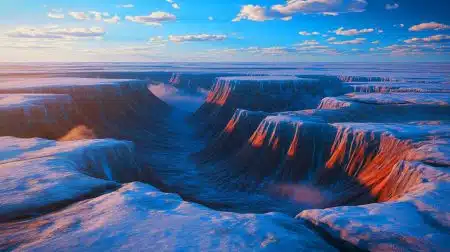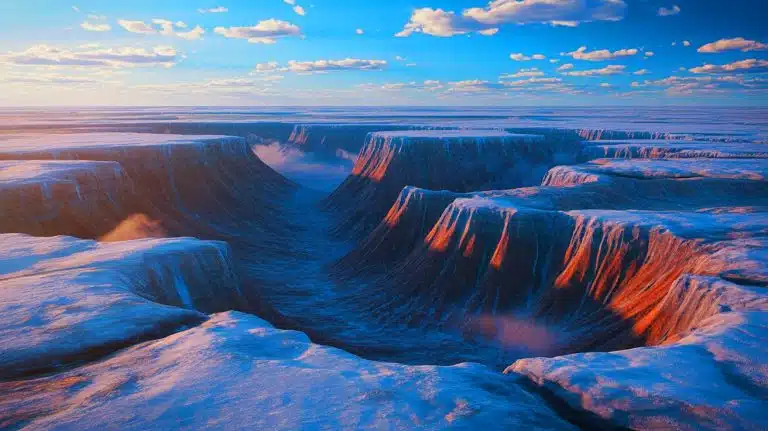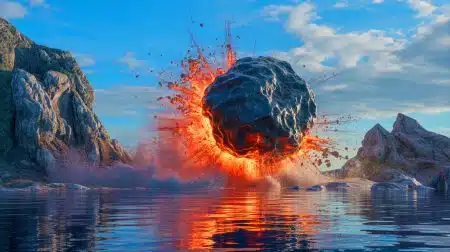| IN A NUTSHELL |
|
Deep in the remote regions of Siberia, the Yamal and Gydan peninsulas present a stark and fascinating geological mystery: massive craters that appear as though the Earth itself has erupted. These gas-emission craters (GECs), first documented in 2014, have captivated both scientists and locals with their dramatic presence. Measuring up to 538 feet deep and almost 100 feet wide, these formations are unlike anything seen elsewhere in the Arctic. Recent research has begun to unravel the origins of these craters, suggesting that they are the result of complex interactions involving methane gas and permafrost. This discovery adds a new dimension to our understanding of geological processes and climate interactions in the region.
Unraveling the Crater Mystery
The discovery of Siberia’s enormous craters posed an immediate geological puzzle. The seemingly spontaneous appearance of these craters, with their steep walls and significant depth, raised questions about their formation. Initial theories pointed to surface-level activities such as the thawing of permafrost and the presence of cryopegs—pockets of salty liquid water that expand and create cavities. However, these explanations fell short when considering the geographical specificity of the craters. If such surface phenomena were responsible, similar craters would likely appear throughout the Arctic, yet they remain isolated to western Siberia.
Recent studies by researchers from the University of Oslo, in collaboration with Russian scientists, have shifted focus from surface processes to deeper geological activities. By examining the physics of the craters’ formation, they developed a model likening the permafrost to a heavy cork atop a pressurized chamber. Their findings suggest that the substantial force needed to create these craters cannot be produced by shallow cavities alone. Instead, the driving power likely originates from larger underground cavities filled with methane gas, which accumulate pressure and eventually erupt through the permafrost.
The Role of Methane and Heat
Methane, a potent greenhouse gas, plays a crucial role in the formation of these craters. The Yamal and Gydan peninsulas are rich in natural gas reserves, with fault lines running beneath them. These faults provide pathways for methane and heat from deep within the Earth to move upward. When these gases encounter the permafrost, they exert pressure until the frozen ground gives way, resulting in a dramatic and explosive release.
Interestingly, this mechanism shifts the perceived role of climate change in crater formation. Rather than directly causing explosions, the warming environment contributes to the weakening of permafrost along fault lines. As temperatures rise, lakes and thawed zones become more prevalent, facilitating the escape of methane. This creates a feedback loop where released methane contributes to global warming, further accelerating permafrost melt and setting the stage for more craters.
Implications for Climate and Geology
The findings from the recent study not only provide a clearer understanding of crater formation but also highlight the broader implications for climate science. Methane is approximately 25 times more effective than carbon dioxide at trapping heat in the atmosphere, meaning that each crater contributes significantly to greenhouse gas concentrations. This adds urgency to the study of these geological phenomena as part of the broader narrative of climate change.
Moreover, the research suggests that similar craters could potentially form in other regions with suitable geological conditions. The presence of natural gas reserves combined with permafrost provides a volatile environment where such eruptions could occur. This emphasizes the need for further geological surveys to identify other potential hotspots and understand their environmental impact.
Future Research and Considerations
The revelations about the Siberian craters open new avenues for research into both geology and climate science. Understanding the intricate dynamics between permafrost, methane, and subterranean heat will be essential for predicting future geological events. As researchers continue to explore these phenomena, they are likely to uncover more about the Earth's deep processes and their interactions with surface conditions.
The study also underscores the importance of interdisciplinary collaboration in unraveling complex natural mysteries. By combining expertise in geology, climate science, and physics, researchers have been able to piece together a comprehensive explanation for these dramatic formations. This approach will be crucial as scientists seek to address similar challenges in understanding and mitigating the impacts of climate change and natural resource management.
The study of Siberia's gas-emission craters offers valuable insights into the Earth's dynamic processes and the intricate interplay between natural resources and climate. As researchers continue to uncover the mysteries of these formations, they pose a compelling question: How might these discoveries influence our strategies for managing natural resources and mitigating climate change impacts in the future?
Did you like it? 4.4/5 (29)








Wow, this is mind-blowing! Can you imagine one of these craters opening up in your backyard? 😮
Wow, this article blew my mind! Who knew the Earth was so explosive? 💥